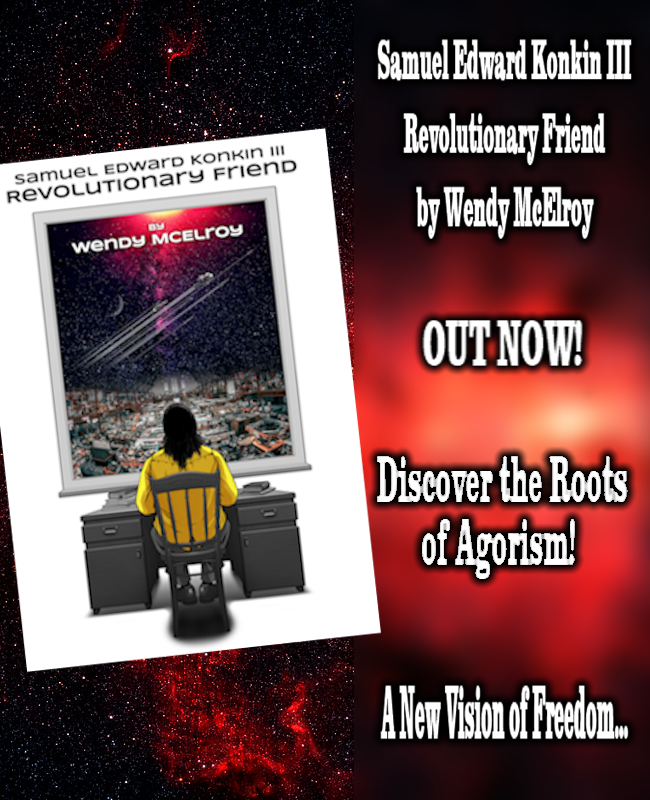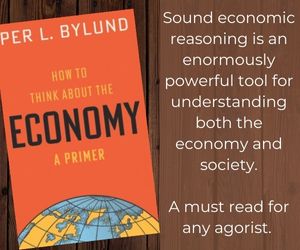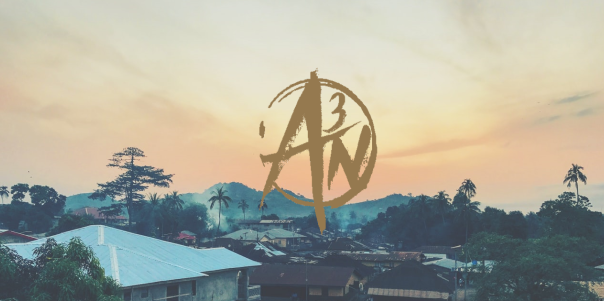
Anarchovillage: Ground Zero of Agorism
Between 1975-1991, a remarkable 16-year-long event occurred just west of Cherry Avenue at 1838 East 7th Street in Long Beach, California: anarchovillage. The village was an apartment complex, along with an adjacent house, which were serially occupied by agorists, anarcho-capitalists, libertarians, frefans, and various other dissidents; they lived alongside the handful of “normal” renters who seemed to be always present as well. The unit’s manager, Chris Schaefer, was technically the founder of anarchovillage. But, from the start, Samuel E. Konkin III (SEK3) was its heart and intellectual core.
[Note: the spelling of key terms such as “anarchovillage” varies in the literature from article to article. Here, the spellings used by quotations are preserved; the spellings used in the narrative are those that are most common.]
A Glimpse of Anarchovillage
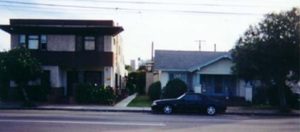 In a 2002 interview entitled “Smashing the State for Fun and Profit Since 1969,” SEK3 offered a sketch of anarchovillage. “There were 10 apartments and a house [to the left], and at our peak we had 8 of them and the house occupied by Libertarians. Two conservative sf writers also lived there, one moving in deliberately to be with us. An old Quaker SDS activist who had holed up there to write SF discovered we had moved in and joined us. No women had their own apartments, but some visited a lot and a few moved in with different men, sometimes sequentially. One in particular worked her way through 90% of us before moving on. And we even had a token gay guy, though we didn’t find out about it for several years (the most promiscuous female, mentioned above, outed him); he was the apartment manager and friend of Dana Rohrabacher’s who originally got us the apartment.”
In a 2002 interview entitled “Smashing the State for Fun and Profit Since 1969,” SEK3 offered a sketch of anarchovillage. “There were 10 apartments and a house [to the left], and at our peak we had 8 of them and the house occupied by Libertarians. Two conservative sf writers also lived there, one moving in deliberately to be with us. An old Quaker SDS activist who had holed up there to write SF discovered we had moved in and joined us. No women had their own apartments, but some visited a lot and a few moved in with different men, sometimes sequentially. One in particular worked her way through 90% of us before moving on. And we even had a token gay guy, though we didn’t find out about it for several years (the most promiscuous female, mentioned above, outed him); he was the apartment manager and friend of Dana Rohrabacher’s who originally got us the apartment.”
In her book Anarchism: Left, Right, and Green, the anarcho-syndicalist Ulrike Heider provided more detail in describing her visit to anarchovillage on a quest to check out SEK3 for herself. As one who often frequented both anarchovillage and SEK3, I know he must have welcomed Heider with the benevolence that he showed to anyone who reciprocated and with the courtliness that he extended to all women. Nevertheless, Heider’s book offers an unflattering account of SEK3—at least, of his political positions. As lamentable as these particular accounts may be, Heider’s physical descriptions are accurate.
“I had pictured the anarcho-village as a kind of free-trader colony of young aspiring businessmen,” she wrote. “I found Konkin’s street in a neighborhood of shabby, flat-roofed houses and rang the bell.” As a long-term anarchovillage resident, Victor Koman, once said of the area, “calling it Bohemian would have be a compliment.”
“The door was opened by a young Latino,” Heider continued, “who showed me into a tiny apartment consisting of a single room. I thought I must be in wrong place—aren’t libertarians supposed to be comfortable, if not affluent? A quick phone call revealed that Konkin III lived…next door [in apartment #3]….Konkin III’s appearance was as unconventional as his dwelling was makeshift. He is a Canadian in his early forties, of stately stature, hair combed back close to his head. Dressed entirely in black, with a turtleneck sweater, a metal belt, cowboy boots, and a silver medallion around his neck, he looks like a cross between a leather guy, a catholic priest, and a romantic fascist. A poster of Trotsky adorned a wall. Konkin III explained to me that Murray Rothbard, who likes to think of himself as the Lenin of the libertarians, once compared him to Trotsky. Despite what I expected from their individualism, as typified, for instance by Ayn Rand’s characters, the inhabitants of the anarcho-village appeared to be as poor as church mice, and as sociable as bohemian collectivists.”
In “Smashing the State,” SEK3 expanded, “Rothbard decided that we…were using Marxist terminology…Some who remained close to him called me the Trotsky of the Movement. So it became natural to refer to us as the Libertarian Left in that context.” Indeed, in the ‘80s, it was chic for radical libertarians to use Marxist rhetoric. Rothbard called his circle “the cadre,” for example. One anarchist, who worked at a respected and semi-conservative institute, displayed a bust of Lenin on his desk next to a photo of he and his partner skiing at Aspen. As much as anything, the language and posturing were for shock value.
But with SEK3 and Rothbard, hard theory lurked immediately beneath the rhetoric. In apartment #3 of anarchovillage, SEK3 refined counter-economics—a strategy of revolution through establishing peaceful black markets, with the goal of creating a stateless society. He wrote and rewrote the New Libertarian Manifesto (NLM), which is the founding document of Agorism—the intellectual underpinning of counter-economics. (“Agorism” is rooted in the Greek word “agora,” which refers to an open-market space.) SEK3 wanted NLM to be to Agorism what Das Kapital was to Marxism.
To SEK3, NLM was an intellectual and practical guide to revolution for hardcore activists. SEK3 said the book was “addressed only to those Libertarian activists at the time who were highly immersed ideologically” in Agorism; in other words, it was meant for anarchovillage sorts and their fellow travelers. NLM was to be the handbook of a new movement—albeit, a tiny one at the moment. Thus, the book was not registered “with the Library of Congress or even mentioned aboveground.” No one seemed more surprised than SEK3 when the “initial press run of 1,000 ran out,” and then the deluxe 2nd edition of about 1,500 did the same. NLM became an Underground Best-Seller even though Laissez Faire Books—then the largest libertarian book store—refused to carry it. “Only foreign Libertarian bookstores like the one in Toronto and, of course, Chris Tame’s Alternative Bookshop in London would carry it. Eventually Laissez Faire and San Francisco’s Freedom Forum Books would sell it under the table.”
Who were the hardcore for whom NLM was written? No one ranked higher at anarchovillage than SEK3’s lieutenant—the science-fiction writer J. Neil Schulman who lived in apartment #6, where he pounded out Alongside Night (1979) on a old-fashioned typewriter. The novel was dedicated to SEK3 not only because he was Schulman’s best friend but also because his “writings on countereconomics were the deep background” of Alongside Night. The novel was the first articulation of Agorism in fiction. It foreshadowed an America that was in economic collapse due to run-away state spending and the monetization of debt. These circumstances produced soaring prices, foreclosures, unemployment, bankruptcy, and a disastrous devaluation of the dollar. In short, they brought about the world we see around us today. Years after the book’s publication, Schulman joked that he intended to sue the U.S. government for plagiarism.
Alongside Night went on to win the Libertarian Futurist Society’s Hall of Fame Prometheus Award and to become a movie. When Schulman produced an audio version of Alongside Night, he acknowledged the importance of his roots by naming the publishing venture AnarchoVillage Productions.
Today, however, those younger than sixty who hear of anarchovillage usually do so through NLM. The Preface to the first edition (1980) reads:
“The basic form of new Libertarianism arose during my struggle with the Libertarian Party during its formation in 1973, and Counter-Economics was first put forward to the public at the Free Enterprise Forum in Los Angeles in February 1974. New Libertarianism has been propagated within and without the libertarian movement and its journals, most notably New Libertarian magazine [which SEK3 published and edited], since then. More importantly, the activism prescribed herein (especially Counter-Economics) has been practiced by the author and his closest allies since 1975. Several ‘anarchovillages’ of New Libertarians have formed and reformed.”
The term “anarchovillage” also arises in NLM’s discussion of New Libertarian strategy. The strategy is meant to “combat anti-principles,” such as miniarchism or limited government, “which strengthen the State and dissipate anarchist energy uselessly.” Instead, SEK3 advocated the direct use of counter-economics and of educating others on this use. The New Libertarian strategy has four phases, from 0-3. In Stage 1, the first counter-economic libertarians appear; North America was at this point when NLM appeared. In Stage 2, “the first few droplets of actual agorist societies—anarchovillages—are nucleating a viable sub-society.” An anarchovillage is defined as a “mid-density, small condensation Agorist society,” and it is the juncture at which the state is most likely “to strike back but [can be] restrained by agorist contamination.” One of the functions of an anarchovillage, therefore, is to defend the community and its members against the state.
Through anarchovillages, a New Libertarian Alliance (NLA) appears. An NLA is “an association of entrepreneurs of liberty for the purpose of specializing, coordinating and delivering libertarian activities.” In “Smashing the State,” SEK3 described the initial entrepreneurial function of the Long Beach anarchovillage. The basic NLA was to be “a ‘labour resource’ for putting New Libertarian out weekly…from December 1975 through January 1978.” (Exploring the dynamics of how the ‘labour resource’ functioned, as this essay does, provides insight into the general strategy of NLAs.)
NLM ends with the words: “Agora, Anarchy, Action! Samuel Edward Konkin III October 12, 1980, Anarchovillage (Long Beach).”
Although the foregoing are NLM’s only mentions of anarchovillage(s), the term is sprinkled elsewhere in SEK3’s writing—for example, in the article “The Global Anarchovillage” published by the Southern Libertarian Review (June 1976). And the NLAs that arise from anarchovillages are a core theme of Agorism itself. How did the Long Beach anarchovillage come to be and function?
SEK3’s Intellectual Journey to the Anarchovillage
SEK3 graduated cum laude from the University of Alberta where he headed the Social Credit League; this is a conservative-populist movement indigenous to Canada. Thus, from his early days of political awareness, SEK3’s activism revolved around building and leading movements.
In 1968, he became a graduate student in chemistry at the University of Wisconsin (UW) at Madison where his roommate, Tony Warnock, eventually introduced him to the writings of Ayn Rand, Ludwig von Mises, Rothbard, and LeFevre. His first embrace of anarchism came through science fiction, however. The Moon is a Harsh Mistress by Robert A. Heinlein is the tale of libertarian colonists on the moon who revolt against the tyranny of Earth. “Heinlein in Moon is a Harsh Mistress first gave me the concept (‘Rational Anarchist’),” SEK3 stated. “When I found out that Bernardo de la Paz was based on a real person (Robert LeFevre), I took it seriously. I progressed through the Canadian and then U.S. Right via Frank Meyer (who, until his death in 1970, attempted a synthesis of conservative and Libertarian, called ‘Fusionism’) and Ludwig von Mises (who called himself a Liberal right up to his death in 1973 at the age of 92; I knew him for his last three years). Both led in different ways to Rothbard but he was being smeared as pro-communist in those Viet Nam War days for his militant isolationism. The final step was provided by an anti-communist free-market anarchist named Dana Rohrabacher at the St. Louis YAF Convention.”
In 1969, SEK3 and Warnock traveled to St. Louis to attend the World Science Fiction and the Young Americans for Freedom (YAF) Conventions; SEK3 was a delegate to the latter. The YAF convention turned into a vicious purge of anarchists and libertarians, prompting SEK3 to abandon the organization in disgust. In an article entitled “A Cram History of the Libertarian Movement. Part II Post-1969,” in the Southern Libertarian Messenger (October 1972), SEK3 described the bitter YAF experience. But he did meet Rohrabacher there; Rohrabacher was a prominent libertarian activist who had been deeply influenced by LeFevre and who now deeply influenced SEK3. Upon returning to UW, SEK3 founded a branch of the Libertarian Alliance at both the university and the state levels. Again, his politics channeled themselves through organizations—rebelling against one and founding another.
In 1970, SEK3 arrived in NYC where became embroiled in the intra-politics of libertarianism, objectivism, and anarchism. The proximate reason for his arrival was to pursue a doctorate in theoretical chemistry at NYU. He refused to complete the required thesis, however, because he believed it could only lead to working for the military-industrial complex. He did form the NYU Libertarian Alliance, however, with a newsletter named NYU/New Libertarian Notes. SEK3 was instrumental in organizing conferences such as the Freedom Conspiracy’s Columbia Libertarian Conference of 1971 where he famously and publicly challenged Milton Friedman for his pivotal role in establishing the withholding tax whereby taxes were the responsibility of employers rather than employees; this made tax evasion far more difficult.
The political reason for his arrival was to meet Rothbard and to learn from Mises. The lasting legacies of SEK3’s stint in NYC included his friendships with Rothbard and Schulman. SEK3 became one of the circle of scholars and activists who attended the frequent discussion meetings in Rothbard’s living room. He met Schulman in 1971 at a meeting of the New York Libertarian Association, which was held in Gary Greenberg’s living room; Greenberg later ran for Governor of New York on the Libertarian Party ticket.
SEK3’s NYC period expressed another theme that presaged his future activism: a commitment to issuing periodicals. He edited the erratically published New Libertarian Notes (NLN, 1971–1975). NLN’s peak came with the serialization of an interview Schulman obtained with Heinlein who had declined such press for decades. When the final installment appeared in 1974, NLN had a circulation of close to a thousand.
The many publications SEK3 created or shepherded illustrate the linear flow that was his life and vision. In California, NLN would become New Libertarian Weekly (NLW, 1975–1977) and then the New Libertarian (NL, 1978-1990)—the magazines around which so much of anarchovillage’s activity swirled. NLN can almost be seen as a preface to the anarchovillage periodicals. In Spring of 1972, for example, it featured a debate between David Nolan and SEK3 on the “Party Question,” which had been inspired by the newly formed Libertarian Party. (An earlier LP had been founded in 1970 but its goal was media attention, not political office.) In California, NLW became the main anti-party voice within libertarianism.
The final issue of NL closed a circle. The high point of NLN was the Heinlein interview; the end of NL was Issue 187, which was an homage to science fiction with a cover that featured Heinlein. The contents included tributes to Heinlein and a previously unpublished letter from him on on “Why I’m Not Bob!” Everything about SEK3’s life and ideas both proceeded in a straight line and came full circle at the same time.
The Creation of Anarchovillage
During much of his stint in NYC, SEK3 lived in a sixth-floor walk-up apartment on East 11th Street which he called “the anarchoslum.” This, too, was prelude.
By July 1975, SEK3 was California bound with three NYC friends and allies: Schulman, Bob “Kedar” Cohen, and Andy Thornton. The promised land of Southern California must have been especially attractive because Rohrabacher, LeFevre and an active LeFevre circle were there. Except for passing a brief period in Las Vegas, SoCal would be SEK3’s home for the rest of his life.
The over packed Toyota took three weeks to arrive at its destination because the trip was non-linear. It included a jaunt to the SF convention Rivercon in St. Louis and to the home of SF publisher Richard E. Geis in Seattle. The trip may have been lengthened by SEK3’s notorious antipathy to driving, at which he was rumored to be quite awful. In “Smashing the State,” SEK3 commented on the drive. “It was right out of Jack Kerouac, and anything but in a straight line….Although I don’t like to drive, by the time we hit Oregon…the rest were so tired they all agreed I should take a turn.” His “turn” was apparently so frightening that no one asked SEK3 to take the wheel again, either on the trip or in the years that followed. SEK3 later described the journey as “a Rite of Passage” and “the defining moment of leaving the ’60s mentality and finally entering that long amorphous period from 1975 until the Fall of the Berlin Wall in 1990.”
On August 10, 1975, the East-Coast refugees arrived in Los Angeles where they spent the first night sleeping on Rohrabacher’s apartment floor. (Rohrabacher later served as a Congressman from 1989 to 2019, representing the anarchovillage’s district. In 1975, however, he was a libertarian activist renowned for writing freedom songs that he sang at Supper Clubs while strumming a guitar.) Chris Schaefer, a friend of Rohrabacher, managed the apartment complex that became anarchovillage. Rohrabacher called and asked him if 4 units were available. They were, and anarchovillage was born. SEK3 bought dinner for everyone on the night the four friends moved in.
The original mission of anarchovillage as “a ‘labour resource’ for putting New Libertarian out weekly” quickly materialized. Schulman explained, “Many, many days were spent collating, folding, stapling, and mailing out magazines (many with articles of mine) with eating and drinking afterwards.” SEK3 contributed the wide range of his own talents to the process. “From 1974 until his death,” Schulman wrote, “SEK3 made his living as a pre-press production specialist in magazine and book publishing, beginning as a typesetter and layout specialist, and eventually becoming an accomplished graphic artist and book designer, skills that served him well in his fan activities, including publishing Libertarian APA Daily FreFanzine at various SF conventions, including Worldcon, since 1996. He was the book designer and producer of over 60 hardcover and trade-paperback books.”
The periodicals flooding out of anarchovillage included NLW, NL, Strategy of the New Libertarian Alliance, New Libertarian Notes & Calendar, New Libertarian: the Newsletter, The New Isolationist, and The Agorist Quarterly. The diversity of periodicals and pamphlets issued by anarchovillage prompted one observer to wryly define libertarians as “people who make a living selling magazines to each other.” In reality, SEK3 firmly grasped the Gandhian insight that a movement needs to have internal periodicals and conversation if it were to bond and grow.
A successful movement also needs culture as well as politics. Anarchovillage found its culture in science fiction and fantasy, with a Dungeons and Dragons game never far away. The Fancyclopedia F3 explains, “In 1975 he [SEK3] with other frefans (libertarian SF fans) founded a Libertarian Science Fiction APA Frefanzine (the first disty [distribution] was collated and distributed at NASFiC 1 [North American Science Fiction Convention]).” SEK3 avoided the editorship of Frefanzine. however, because he believed his radical politics could alienate some SF fans, but SEK3’s active participation reflected his deep belief that fiction, especially SF and fantasy, were more important in changing society than nonfiction. The language he used also reflected the depth of his commitment. When he and Rothbard seriously fell out, SEK3 described his nemesis as the “Darth Vader” of the Movement. Rothbard reciprocated by calling the SEK3 circle “space cadets.”
Schulman carefully pointed out, SEK3’s “fannishness was not a hobby but the core of his libertarian mission. SEK3 published, made editors of, and inspired the current generation of libertarian science fiction writers, who have won media and publishing credits, critical acclaim, renown, and sales equaling or exceeding that of our generation’s libertarian nonfiction lights.” Thus, anarchovillage was a hotbed of SF writers, ardent fans, and literary discussion.
During this period, SEK3 also co-founded the New Libertarian Alliance, the Movement of the Libertarian Left (MLL), the Karl Hess Society and supper club, as well as serving as Executive Director of The Agorist Institute think tank.
This buzz of activity was intended to form the intellectual and culture spine around which a broader movement could form. In his article “The End of the Libertarian Movement” (New Libertarian Weekly, May 30, 1976), SEK3 described one reason why the Movement of the Libertarian Left was unique.
“Let’s tackle the concept of ‘movement’. All ‘movements’ have a goal—to transform the society they live in. When they have done so, it will be a new society. Most movements explicitly assert this. Libertarians are unique in that they will not attempt to compel a complete change in the society they are in. They will leave some alone who freely (and perversely) choose to reject membership in the libertarian society. This then, is the big step in my logic. A libertarian society, except by the most improbable accident, will co-exist with non-libertarian societies.”
The New Libertarian strategy was to educate the broader public while, at the same time, forming stateless societies that functioned in parallel and in peace.
The Agorist Institute constituted SEK3’s attempt to infuse his philosophy with a more scholarly flavor. SEK3 described the Institute’s genesis, referring to himself in the 3rd person. “On December 31, 1984 The Agorist Institute was formed on that symbolic date and with the logo of ‘the tip of the iceberg’. So in 1985 MLL was turned over to Victor Koman and Mike Gunderloy while SEK3, J. Kent Hastings and John Strang concentrated on AI. The New Isolationist newsletter combined the editorial skills and writings of Konkin and Royce, with Alexander Cockburn and Noam Chomsky from the New Left, Thomas Fleming and Charles Reese from the Old Right, and many other anti-interventionists.”
Heider offered a physical description. “The Agorist Institute, the headquarters of the MLL, is located in an office building in downtown Long Beach, a city whose numerous palm trees lend it a tropical flair. The office consists of two cramped rooms equipped with two computers. Science-fiction posters cover the walls. The institute, I learned, is ‘technically legal’, a non-profit, tax-deductible project ‘supported by libertarian business people who feel guilty for being too honest and legal’.” SEK3 was undoubtedly referring to some members of the Founding Board of Directors who included financial gurus and businessmen Doug Casey, John Pugsley, and Robert Kephart. Rothbard, LeFevre, and Hess also formed the Board’s ranks.
Taken together, the explosion of periodicals and pamphlets, of novels and conferences, of the Institute and discussion clubs may have resembled a chaotic jumble had it not been for one thing. Everything revolved around the themes of counter-economics, Agorism, and anarchism. They were all part of a seamless web.
SEK3: The Soul of Anarchovillage
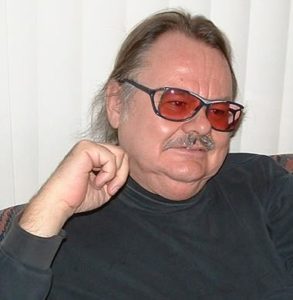
A community and a movement require the human connections that sustain long-term relationships. SEK3’s character was invaluable in filling this need.
SEK3 was modest about his genius, but more than that. He did not use it to make people feel as though they were ignorant or inferior. This may have been particularly important to women. At SEK3’s memorial service, one female speaker praised him for never making her feel “dumb.” I would phrase the sentiment differently; SEK3 always made me feel intelligent and interesting. He did so without backing away from aggressive arguments and advocacy. He simply argued according to what the iconic individualist-anarchist Benjamin Tucker called the “Plumb Line”; that is, he proceeded from the facts directly down to a conclusion without digressing into personal attacks, manipulation, or other irrelevancies.
With a broad encyclopedic knowledge, SEK3 went out of his way to make people feel comfortable. Another speaker at the memorial told of bringing his teen-aged, non-political son to an anarchist gathering at which SEK3 chatted affably with the boy about a punk rock group making inroads in the Pacific Northwest. SEK3 paid close attention to cultural trends because they revealed the zeitgeist of society more accurately than politics or economics. At the Anaheim World Science Fiction Conference, he and I platonically shared a two-bed hotel room in order to cut down on costs. We were a good match as roommates. When I woke in the morning to hit the panels and talks at a dead trot, SEK3 was arriving back from party hopping through the night. This is how I discovered that liked to sing the score of “Rocky Horror Picture Show” in the shower.
He was an intellectual egalitarian. That is, SEK3’s intellect was available to all. He was blind to whether a person was rich or poor, male or female, a newcomer or a veteran to the movement. His main prejudice: he was an adamant night owl who vastly preferred to be conscious in the quiet, dark hours. But when SEK3 was awake, anyone could knock on his door to chat for an hour or a day and then go out to eat.
SEK3’s most important contribution to building movement and community, however, was his uncanny ability to motivate people to do their best work. In his presence, ideas became the most important things in the world. Why else could motivate so many volunteers to work for years at the grunge tasks required to produce movement periodicals? His motivation was not driven primarily by self-interest, however. SEK3 urged those around him to excel in their own careers and endeavors. Schulman credited him with creating “the deep background” for Alongside Night, which allowed the novel to go on and win a Prometheus Award. Koman said SEK3 inspired the Prometheus-award winning novel, Solomon’s Knife; indeed, Koman felt so bonded to SEK3 that he asked him to be the godfather to his only child. Brad Linaweaver, co-editor of the Prometheus-award anthology, Free Space, referred to SEK3 as the book’s “spiritual cheerleader.” Just as Heinlein had drawn upon LeFevre to create Bernardo de la Paz, several SF writers drew upon SEK3 to craft heroes in their libertarian novels. Besides Alongside Night, SEK3’s persona was echoed in L. Neil Smith’s The American Zone and in Koman’s Kings of the High Frontier.
A rare and non-hierarchal camaraderie pervaded anarchovillage. Schulman rendered a sense of this easy comradeship. “When I was broke in those day’s, Sam was always happy to pick up the check and lay a ‘meal ob’ [meal obligation] on me, a concept we got from Eric Frank Russell’s libertarian SF novel, The Great Explosion. A few years later I returned the favor when I set Sam up in an apartment he dubbed the AnarchoVilla, on Overland Avenue in Culver City. That apartment was production central for my book publishing. Sam was the production backbone and book designer for every book that came out from Pulpless.Com, and a talented graphic artist for many of the covers.”
This is the truest indication of SEK3’s charisma and benevolence: those who were drawn to him offered back a thing as rare as unconditional love—that is, lifelong friendship and loyalty. The synergism sustained anarchovillage. Without the village and the cadre, SEK3’s call to “Agora, Anarchy, Action!” would not echo as it does through generations, growing stronger with each iteration.

